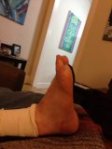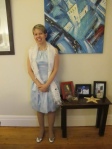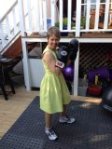I am slightly overwhelmed as I sit down to write this latest post.
So many people have asked me what has happened in my recovery process since the last time I wrote, now over 10 months ago. I feel the pressure to be one of the ambassadors for this unfair condition – this unsexy disease called Charcot Marie Tooth (CMT). CMT affects 1 in 2,500 people worldwide, making it one of the most common genetic disorders. Sadly, it is also one of the least funded conditions (damn that cancer!), even though it negatively impacts so many people. So we need more voices to talk about what hope there is for treatment and recovery.
I also feel inspired by all of you who have written to me with your similar stories. I am prompted to continue my writing in order that I may help others rediscover optimism that they too might get help. I am hopeful and optimistic that others will feel the relief and joy that is now mine.
That’s right! My story continues with gratitude to my doctors, Dr Andrew Ellis and Dr Grace Warren, in North Sydney, Australia. My story is accompanied by relief that I am now able to do many of the things that others take for granted, like walking with normal shoes and stepping out to dinner in fab boots or cute ballet shoes. My story continues with ongoing work – hard work at times – and regular exercise. I continue to get stronger whilst pushing myself out of my comfort zone, challenging my beliefs about what I can and cannot do post surgery.
Through my story, I will try to answer as many of your questions as I can. I am going to let Robyn, the latest person to share her challenges with CMT, help me to answer your many queries and concerns. I hope this will bring a sense of optimism, shared experience and, ultimately, lead to a great result for those who decide to pursue surgery, as I did.
Here are Robyn’s questions:
- How far can you walk now?
- Do you have to sit and rest after a certain amount of time?
- What about walking on uneven ground?
- Would you / have you considered hiking with your new feet?
- What about going up and down stairs? Can you do it without a hand rail?
- Are you still exhausted at the end of the day?
How far can you walk now?
Last weekend I completed a 7km hike around a beautiful lake in Nanaimo, BC. It was a gentle and mostly flat walk that could be completed easily in runners. However, it was the longest walk I have challenged myself to take since my second, follow-up operation (more about that in my next posting). It was only in the final few steps of the walk that I felt a bit of a twinge in my right foot – and perhaps that was just a psychological reaction as I could see the end of the walk.
Do you have to sit and rest after a certain amount of time?
I really don’t have to rest anymore!
This was not at all the case when I came out of my casts. When I was released from my leg casts, I found myself staring down at two shriveled excuses for calves. Of course, this happens to anyone who has had to wear casts for a prolonged period of time; in my case, this was a total of six weeks. What Drs Ellis and Grace did not tell me – did not think to tell me! – was that it takes far, far longer for a person with CMT to recover from muscle atrophy. Far, far longer!
I found myself in Dr Ellis’ office, 10 months after surgery, crying with frustration and anger because I felt worse off than I had prior to surgery. He sympathetically advised me that my muscle recovery would likely take another 12 to 18 months for them to get back to the strength they had been originally.
What??!! And that was only with an intense regime of regular swimming, cycling, walking and my myriad of static exercises! I was pissed, frustrated and ultimately, annoyed with him. How could he not emphasize that fact prior to me spending 25K and months of my time?!
That news was delivered to me around the time of my last posting in July 2013. Perhaps that explains why I have been ambivalent about writing another post!
But here I am another nine months later from that visit to his office. I am getting stronger by the month. I say ‘month’ as the changes are too small to see weekly; however, I have noticed a significant shift in my strength and pace since I began walking three times a day with my new dog, Mack. Suddenly, within five weeks, I noticed a huge difference in my endurance. The seven kilometre walk, and recent long walks on the seawall and forest paths, are completed with little conscious thought. Like any person with normal mobility, I am starting to take for granted my ability to walk long distances. It is a joyful delight to actually ‘forget’ about walking!
What about walking on uneven ground?
That is good now too. I love walking on sand in bare feet and trekking through forest paths. With my arches drastically reduced, such that they are now considered ‘normal’ (though still high), I have so much more ground under my feet. This was the very first thing I noticed when my casts came off. No longer did I wobble when I stood for any length of time. Instead, I felt firmly connected to the ground for the first time in my life.
Balancing on one leg can still be challenging, but that is largely due to my still-weak calves. But this too is getting better. I went to a concert last May and found it challenging to stand for the whole concert. I was stronger during the next concert I attended in September. Last night, it was no problem for me to queue for an hour to get into a venue. Thus, progress continues over the months.
Would you / have you considered hiking with your new feet?
Absolutely. My boyfriend and I are plotting many upcoming hikes. As I noted, I am starting slowly with more even ground. It is still challenging for me to mount large steps due to muscle strength in my calves and hamstrings. But I have big dreams for Summer 2015 when I am considering doing the West Coast Trail with him. That will require regular training by getting outside and on the trails. My big dream – the one that I dreamt of doing when I saw the film, The Way – is to complete at least part of the ‘El Camino de Santiago’ in Spain.
So rather than being deflated by all that I cannot do, I am excited for the future!
What about going up and down stairs? Can you do it without a hand rail?
Going up stairs continues to be tiring for me. It has been my number one complaint since my post-operative muscle atrophy. But it’s getting better – SLOWLY. I have been seeing a new physio since November (I now live back in Vancouver), and he has given me lots of great exercises that I can do at the gym or at home. I chose to work with Nate Mundy because, though young, he has worked before with people who have CMT. I knew this was a better option than working with someone in Sports Medicine who might be challenged by my very basic needs and slow progression. Nate has been awesome, patient and encouraging. In the last month, I must say that I haven’t done my exercises – at all! – whereas I had been doing them diligently three times a week. Fortunately, all of the walking I have been doing has produced much faster results than my static strengthening exercises.
As for going downstairs, I do sometimes use the handrail, but that it is becoming less frequent as I develop greater trust in my strength and balance. Shortly after surgery in the Autumn of 2012, the place where my foot bones meet the tibia (the bone at the base of the leg), felt like they were grinding together. This made walking down stairs awkward and jerky. I would have to hop down the stair when on my right leg. This really scared me. I had gone through this intense surgery, full of joy and excitement for my future well-being, only to find that I had walked down stairs better before the surgery!!
I took out my anger and frustration on my physio at the time, Dan Gartner. Luckily he took it in stride and gave me additional exercises – more bloody exercises! – to stretch and release the top of my ankle from the tibia. I remember only doing those exercises for a month or so before the problem righted itself. Now I go down stairs without favouring either foot.
On steep stairs or hills, as on my lake walk, I still exercise caution. My body remembers how often I went over on my ankles! However, I grow evermore confident.
Are you still exhausted at the end of the day?
No!
I should point out that I have CMT Type 1A, the mildest version of the disease. I have always been able to do cardio exercise (using the stationary bike or swimming) with relative ease. However, when I re-started my fitness regime with Nate in November, 14 months after surgery, I did tire very easily. It was discouraging to use the stationary bike and be challenged to get through 20 minutes when I had regularly attended 45-minute spinning classes with aplomb.
I am happy to report that cycling is no longer tough. I can now rock out to Rage Against the Machine or Queens of the Stone Age at that fast, angry tempo. I enjoy it was again rather than being discouraged.
I will end this post by saying that Dr Ellis did indeed warn me that the recovery process was ‘grueling’. Whilst I nodded and agreed to the terms put in front of me, I was too excited by the longer term results to give his words their proper consideration. One of the reasons I started this blog was to give people information that there are surgeons who can help with CMT from a structural point of view. This operation has made my life and my living infinitely easier.
But I also need to emphasize the emotional toll of going through the recovery process. The operation itself was a breeze – I didn’t have to do the six hours of work (two surgeons, each working on one foot, did that!). But the rehabilitation process requires patience, perseverance and a positive attitude. I lost all three of those at the 10-month mark. It was hell and I got depressed about it – literally. It took me a couple of false starts and a good four months to get back on track, and it required a great deal of my emotional strength and support from others to do so.
I can say today that it has all been worth it for what I have gained in mobility, pace and new shoes!! Thank you again to Drs Ellis and Warren for giving me a new lease on life. I will be forever grateful.
My next blog entry will address my second, follow up operation I had last April to correct four of my toes, and I will seek to fill in more blanks to your questions. I will also post some ‘before’ and ‘after’ photos.
Please continue to read and write to me. It makes my efforts worthwhile to know that I am helping others.
Best wishes for all of you, Christa



